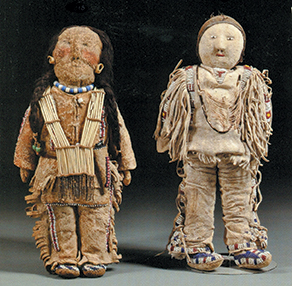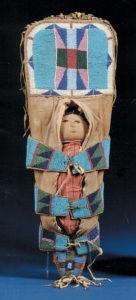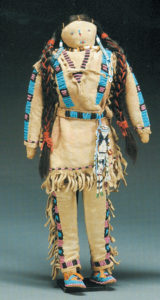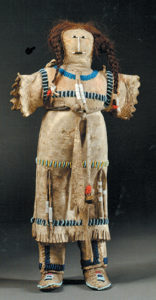 By Robert Reed
By Robert Reed
In the National Museum of American History in the nation’s capitol is a black and white image of a beautiful Crow Indian girl with doll in a traditional cradle. The photograph was taken in 1888.
Like children everywhere, Native American children have loved to play with dolls over the centuries. In most cases such dolls for them were fashioned by materials immediately available to them in forms of dress similar to their tribal people.
“By mirroring a tribe’s use of ornament, accessories, and clothing,” noted Wendy Lavitt in the 1982 book American Folk Dolls, “the dolls accurately recorded Indian life.”
And “for most Indian children,” confirmed author Lavitt, “dolls were an integral part of childhood.”
Another doll expert, Stuart Holbrook of Theriault’s explained a decade ago that Native American dolls enjoyed an innocence within the early Indian culture
in that “they were actually playthings rather than ceremonial presentations therefore squarely within the romantic definition of dolls.”
 Historians note that some Native American dolls fell under the influence of early explorers from Europe. Accounts dated as early as the 1500s tell of Indian children playing with dolls including such some that had been brought from England.. A leading auction house, Skinner Inc. reported selling a 19th century Indian doll in a European wax-over composition form with glass eyes. Originally from the Northeast part of America it bore beaded leather clothing and cloth pucker-toe moccasins and a beaded leather peaked cap. More recently it had been from a collection in England.
Historians note that some Native American dolls fell under the influence of early explorers from Europe. Accounts dated as early as the 1500s tell of Indian children playing with dolls including such some that had been brought from England.. A leading auction house, Skinner Inc. reported selling a 19th century Indian doll in a European wax-over composition form with glass eyes. Originally from the Northeast part of America it bore beaded leather clothing and cloth pucker-toe moccasins and a beaded leather peaked cap. More recently it had been from a collection in England.
Examples of 19th century Plains Indian dolls might include beaded hide dress and moccasins, sometimes even with detailed necklaces and other ornaments. Some Central Plains dolls of the latter 19th century included costumes partly or fully made of buffalo hides. Some, like the historic 1888 photo, have been complete with doll-sized cradles.
Crow Indian dolls of the late 19th century have been found in wood form with muslin coverings and classic Crow beadwork. Other 19th century Crow doll examples have been in cloth form a varying extent of decoration.
Typically existing 19th century Indian dolls range from ten to 15 inches in height, female, and made of regionally available materials. An exception was a late 19th century male Comanche recently sold at a major auction house. The doll was 31 inches in height and wore a traditional shirt, leggings, and tin cone decorated moccasins. It had bead eyes, and formed hands with figures sewn separately.
 Early Eskimo Inuit Indian dolls were usually made of wood and leather and made to sometimes be carried in the parka. Like elsewhere however they were variations over the generations.
Early Eskimo Inuit Indian dolls were usually made of wood and leather and made to sometimes be carried in the parka. Like elsewhere however they were variations over the generations.
Obviously materials varied with what was available at a given time and also with the talents and interests of a given Indian doll maker.
“Difficulty lies in dating both American Indian and Eskimo dolls,” noted Holbrook. “In many cases exact production techniques were used for generations, creating this difficulty.”
The testimony of Native American Blackfoot Beverly Hungry Wolf supports the early commentary. Wolf in the volume on American Folk Dolls:
“All that I played with was part of our culture. I had a lot of dolls. I was a great one for making dolls. I used wires to start them, then I wrapped the wires to make their bodies, and then I dressed them in Indian clothes.”
Wolf added, “Those of us who had the longest hair donated some of it to make hair for our dolls. Then the boys would hunt gophers and squirrels and skin them and we would make the little skins into clothing for the dolls.”
An early 20th century Cheyenne doll might have a cloth body be wearing a beaded leather dress, and wool yarn was sometimes used on such dolls as hair. Depending on what was available to the maker such dolls of that period and region might have further decorations carved from real animal bone or teeth.
In recent years Skinner Inc. sold at auction a rare Cherokee cloth doll in the image of an African-American salve. The female subject was wearing a cloth turban with a beaded decoration, and was holding a Cherokee baby in a wooden cradle. The seller estimated the doll was crafted during the early 20th century or before.
 An early 20th century Lakota Indian doll was also offered at the same event. From the Wistariahurst Museum, the piece was wearing a full yoke beaded dress with applied hair. It bore hand-drawn facial features and was wearing beaded early ornaments and a necklace. It was about 20 inches tall.
An early 20th century Lakota Indian doll was also offered at the same event. From the Wistariahurst Museum, the piece was wearing a full yoke beaded dress with applied hair. It bore hand-drawn facial features and was wearing beaded early ornaments and a necklace. It was about 20 inches tall.
Still another example was a 1900s Central Plains Indian dolls. It wore a woman-style breast plate, partially beaded dress and moccasins. It also had braided hair and face paint. The doll was just over 14 inches tall with a basic beaded hide form.
In 2004 American Indian Art Magazine featured a carved wood Northeast Indian doll on its cover. The doll had articulated limbs, face and hands. It was fully costumed with a buckskin shirt, leggings, and claw necklace along with a miniature headdress and miniature double-curved bow. From a private collection, the 14-inch doll was later sold at a nationwide auction.
The main focus of the above has been that of Indian dolls were made for and used by children as playthings. Two categories might be included in the broader definition of Indian dolls.
One such group would be dolls used as ceremonial objects that were often used in religious rites. An example would be the Hopi Kachina dolls, but there were many others by various Indian tribes over the ages.
Another type of Indian doll would be the commercial dolls made to appear as Native Americans. During the 1890s and early 1900s, even while Native American dolls were being crafted for ethnic children, European and American manufacturers were marketing there version of Indian dolls. In 1897 the J.D. Zernitz Company advertised Indian dolls with bisque heads and glass eyes in various sizes from ten to 15 inches tall. Butler Brothers advertised similar dolls in 1910.
Today there are serious collectors for all three types of enduring Indian dolls.
Indian doll captions:
Two early 20th century Plains Indian beaded hide dolls. (Skinner Inc.)
Crow doll and doll cradle, late 19th century. Beadwork on hide. (Skinner Inc.)
Plains beaded hide doll, ca. 1900, with beaded leggings and moccasins. (Skinner Inc.)















Follow Us